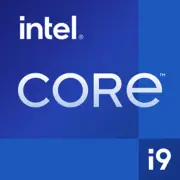Intel Core i9-9900KF

Intel Core i9-9900KF nel 2025: vale la pena prendere il leggendario processore per il montaggio di un PC?
Introduzione
Il processore Intel Core i9-9900KF, rilasciato nel 2019, è diventato un simbolo dell'era delle CPU desktop ad alte prestazioni. Nonostante i suoi anni, nel 2025 attira ancora l'attenzione degli appassionati e di chi cerca un upgrade economico. Esaminiamo se questo chip sia ancora attuale oggi e a chi possa adattarsi.
Caratteristiche principali: Architettura Coffee Lake e le sue peculiarità
Nome in codice e processo tecnologico:
L'i9-9900KF è basato sull'architettura Coffee Lake (14 nm++), che nel 2025 appare obsoleta rispetto ai chip AMD e Intel da 5-7 nm. Tuttavia, i 14 nm++ hanno permesso a Intel di raggiungere elevate frequenze operative: base di 3,6 GHz, modalità turbo fino a 5,0 GHz (in overclock).
Core e thread:
8 core e 16 thread è una configurazione che riesce ancora a gestire i giochi moderni e i compiti multithreaded. Ad esempio, il rendering in Blender o lo streaming in OBS Studio non generano ritardi critici.
Cache e prestazioni:
La cache L3 da 16 MB garantisce un rapido accesso ai dati. In Geekbench 6 (2025), il chip mostra:
- 1689 punti (Single-Core) — comparabile con Ryzen 5 7600X (1700-1750);
- 8052 punti (Multi-Core) — inferiore a Ryzen 7 7700X (~9500).
Caratteristiche chiave:
- Moltiplicatore sbloccato per l'overclocking.
- Supporto per Intel Optane Memory (rilevante per build economiche senza NVMe).
- Assenza di grafica integrata (risparmio di $20-30 rispetto a i9-9900K).
Schede madri compatibili: Socket LGA 1151 v2 e chipset
Socket: LGA 1151 v2 (non compatibile con la prima versione per le generazioni Intel 6-7).
Chipset:
- Z390 — scelta ottimale per l'overclocking (ASUS ROG Maximus XI Hero, MSI MPG Z390 Gaming Pro Carbon). Supporta PCIe 3.0, RAID, Wi-Fi 6 (nelle versioni premium).
- H370/B365 — per build di base senza overclocking (ASUS TUF H370-Pro).
Particolarità nella scelta nel 2025:
- Nuove schede non sono prodotte — cercate rimanenze (prezzo $120-250) o usate ($80-150).
- Aggiorna il BIOS prima di installare il processore (alcune schede richiedono versioni dal 2019 in poi).
- Evitare modelli economici con VRM senza dissipatori — durante l'overclock possibile surriscaldamento.
Memoria supportata: DDR4 e le sue limitazioni
- Tipo di memoria: Solo DDR4 (DDR5 non supportato).
- Frequenze: Ufficialmente fino a 2666 MHz (sui chipset H370/B365), ma su Z390 può essere overcloccata a 4000+ MHz (dipende dalla scheda).
- Raccomandazioni:
- Il miglior rapporto qualità-prezzo — DDR4-3200 CL16 (ad esempio, Corsair Vengeance LPX 32 GB).
- Nel 2025, DDR4 è più economica del 30-40% rispetto a DDR5, il che riduce i costi complessivi della build.
Alimentatore: Calcoli per un funzionamento stabile
- TDP del processore: 95 W, ma in overclock a 5.0 GHz il consumo raggiunge 150-170 W.
- Potenza raccomandata dell'alimentatore:
- Senza overclock: 500-600 W (con scheda video di livello RTX 4060).
- Con overclock e RTX 4070/4080: 750-850 W.
- Esempi di modelli:
- Budget: EVGA 600 GD (80+ Gold, $70).
- Premium: Corsair RM850x (prezzo 2025 — $130).
Importante: Non risparmiare sull'alimentatore — i processori vecchi sono sensibili alle fluttuazioni di tensione.
Pro e contro dell'i9-9900KF nel 2025
Pro:
- Prezzo accessibile: usato — $150-200, rimanenze nuove — $250-300.
- Alta IPC (prestazioni per ciclo) — nei giochi compete con Ryzen 5 7600X.
- Facile overclocking con raffreddamento ad aria (ad esempio, Noctua NH-D15).
Contro:
- Nessun supporto per PCIe 4.0/5.0 — SSD discreti (ad esempio, Samsung 990 Pro) funzionano a metà velocità.
- Processo tecnologico obsoleto — elevato consumo energetico sotto carico.
- Aggiornamento limitato: il passo successivo è solo cambiare piattaforma (LGA 1700/AM5).
Scenari d'uso: Gaming, rendering e non solo
1. Giochi:
- In Full HD/1440p con RTX 4070: Cyberpunk 2077 — 80-90 FPS (nelle impostazioni alte).
- Le prestazioni sono vicine a quelle di Ryzen 5 5600X, ma nel multiplayer (ad esempio, Warzone) possono esserci cali a causa dei core vecchi.
2. Compiti lavorativi:
- Montaggio video in Premiere Pro: rendering di un video 4K in 12-15 minuti (contro 8-10 minuti con Ryzen 7 7700X).
- Programmazione: compilazione del codice in Android Studio avviene senza ritardi.
3. Multimedia:
- Streaming in OBS + gioco — carico della CPU al 70-80% (richiede una configurazione precisa dell'encoder).
Confronto con i concorrenti
1. AMD Ryzen 7 5800X (2020):
- Pro: supporto PCIe 4.0, minore consumo energetico.
- Contro: più costoso del 20-30% (usato — $180-220).
2. Intel Core i5-13600K (2022):
- Pro: 14 core (6P+8E), DDR5, PCIe 5.0.
- Contro: una nuova build costerà $300 in più.
3. Ryzen 5 7600X (2022):
- Pro: IPC superiore del 15%, supporto AM5.
- Contro: richiede costosa DDR5.
Conclusione: l'i9-9900KF vince solo nel segmento economico ($300-400 per l'intera build).
Consigli pratici per la build
1. Raffreddamento:
- Minimo — dissipatore ad aria DeepCool AK620 ($60).
- Per overclocking — AIO Arctic Liquid Freezer II 240 ($90).
2. Scheda madre:
- Cerca modelli con Wi-Fi e USB-C (ad esempio, ASUS ROG Strix Z390-E).
3. Memoria RAM:
- 32 GB DDR4-3600 — ottimale per giochi e multitasking.
4. SSD:
- Scegli NVMe con PCIe 3.0 (WD Blue SN570 1 TB — $70).
Conclusione finale: A chi si adatta l'i9-9900KF?
Questo processore è da considerare in tre casi:
1. Upgrade di un vecchio sistema su LGA 1151 v2 — sostituire l'i5-8400 darà un incremento di FPS del 40-50%.
2. Build di gioco economica — in accoppiata con GPU di livello RTX 3060/4060.
3. Appassionati di overclocking — esperimenti di overclocking ad aria.
Alternativa: Se il budget permette $500+ — è meglio prendere Ryzen 5 7600 o i5-14600K con prospettiva di aggiornamento.
L'i9-9900KF nel 2025 è un "cavallo da battaglia" per chi apprezza il bilanciamento tra prezzo e prestazioni, ma è disposto a convivere con tecnologie obsolete.
Di base
Specifiche della CPU
Specifiche della memoria
Varie
Classifiche
Rispetto ad altre CPU
Condividi sui social media
Oppure linkaci
<a href="https://cputronic.com/it/cpu/intel-core-i9-9900kf" target="_blank">Intel Core i9-9900KF</a>